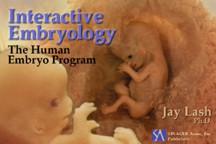
Prev Page |
Home Page

Jay Lash
Interactive Embryology: The Human Embryo Program CD, 1998
Sinauer Associates, Inc., Sunderland, MA
ISBN 0-87893-448-0
Introduction
Interactive Embryology had its beginning as a class venture for the Embryology course at the University of Pennsylvania School of Medicine. Five medical students and the Office of Computer Technology played a major role in the creation of the prototype version. After many trials at other universities and colleges in United States, Canada, England, and Finland, it was rewritten, redrawn, and redesigned.
The core of the program is a series of movies simulating developmental events in human embryos. Its highly interactive design allows viewers to stop the movie and interact with diagrams that both identify and describe what is being seen, and discuss related concepts. Developmental processes and tissue movements that students have had great difficulty in understanding from serial sections, diagrams, and descriptions in textbooks can now be seen and explained firsthand.
The program contains eleven chapters. The first chapter is an overview of human development from fertilization to birth; ten subsequent chapters go into more detail about selected tissues and organs.
While originally conceived for a medical school, nursing school, and allied health professional audience, Interactive Embryology is appropriate for use in undergraduate and graduate courses in Human Biology, Embryology, and Developmental Biology, as well as for the layperson interested in animated simulations of embryonic and fetal development.
Contents
- 1. Overview
- This segment portrays major events during development through the embryonic and fetal periods, including implantation, germ layer formation, and the major morphological external changes as the fertilized egg is transformed into the fetus at the time of birth. As the embryonic period ends, and the fetal period begins, there is a discussion of the term "pre-embryo."
- 2. Gastrulation
- This chapter explains, through movement and words, how the primary germ layers are formed, and how the basic body organization is created. The structures of segmentation and possible genetic determinants are discussed.
- 3. Neurulation
- This chapter portrays the movements associated with neural tube closure, and shows how birth defects such as Anencephaly and Spina Bifida can occur. The essential nature of neural crest cells, which appear during neurulation, is shown and explained.
- 4. Heart
- The heart is the first organ of the body to function. This segment simulates the development of the heart from the initial stages of precardiac mesodermal cells to the formation and elaboration of its complicated chambers and vessels. Attention is given to how human heart development differs from that of lower vertebrates.
- 5. Eye
- As one of the major organs, eye development is followed in movies and text through the embryonic and fetal periods.
- 6. Ear
- The ear, like the eye, is a special sense organ, and the two share certain developmental processes. This segment shows the development of the ear from the initial invagination of the otic placode to the final formation of the ear and its associated structures.
- 7. Branchial (Pharyngeal) Arches
- The complicated origin and differentiation of the branchial arches is shown through color-coded movies with explanatory text concerning the fate of these structures.
- 8. Gastrointestinal
- The development of the gastrointestinal tract is portrayed, with arrows and text, as it undergoes its well known, but poorly visualized, gut rotation.
- 9. Urogenital
- This section addresses the early embryonic development of the urogenital system, one of the more complicated systems to develop during embryonic life. The movie and text first cover the early embryonic period when the embryo is ambisexual. At this time it is impossible, except through chromosomal analysis, to determine whether the embryo will be male or female. Then male differentiation, female differentiation, and the origin and differentiation of the prostate gland are shown and discussed.
- 10. Limbs
- The development of the limbs is very complicated, involving scores of muscles, bones, ligaments, and associated cells and tissues. This chapter deals with two aspects of limb development: genetic determinants, and the rotation of limb elements during embryonic and fetal development.
- 11. Face
- It is not until one observes a face with an anomaly such as Cleft Palate that it becomes obvious that the human face is composed of various components. This segment, using color-coded regions, follows the embryonic development of facial components, until they come together to form the normal configuration of a face.
Prev Page | Home Page
 SOCIETY FOR DEVELOPMENTAL BIOLOGY
SOCIETY FOR DEVELOPMENTAL BIOLOGY
SDB Webmaster
Posted Thursday, October 21, 1999

 SOCIETY FOR DEVELOPMENTAL BIOLOGY
SOCIETY FOR DEVELOPMENTAL BIOLOGY